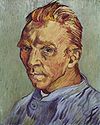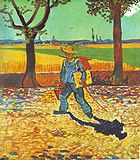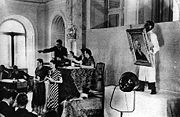
Self-Portraits by Vincent van Gogh
Encyclopedia

Vincent van Gogh
Vincent Willem van Gogh , and used Brabant dialect in his writing; it is therefore likely that he himself pronounced his name with a Brabant accent: , with a voiced V and palatalized G and gh. In France, where much of his work was produced, it is...
created many self-portrait
Self-portrait
A self-portrait is a representation of an artist, drawn, painted, photographed, or sculpted by the artist. Although self-portraits have been made by artists since the earliest times, it is not until the Early Renaissance in the mid 15th century that artists can be frequently identified depicting...
s during his lifetime. Most probably, Van Gogh's self portraits are depicting the face as it appeared in the mirror
Mirror image
A mirror image is a reflected duplication of an object that appears identical but reversed. As an optical effect it results from reflection off of substances such as a mirror or water. It is also a concept in geometry and can be used as a conceptualization process for 3-D structures...
he used to reproduce his face, i.e. his right side in the image is in reality the left side of his face.
Paris 1887
Arles

Saint-Rémy
All Self-Portraits executed in Saint-Rémy show the artist's head from the left, i.e. the side with ear not mutilated.Auvers-sur-Oise
No self-portraits were executed by Van Gogh in Auvers-sur-Oise, during the final weeks of his life.Scandals
During the Third Reich regime in Germany, Vincent van Gogh paintings were stolen and/or destroyed by German authorities including the self-portrait [Self-portrait dedicated to Paul Gauguin, September 1888], depicted in the black and white photograph below.
Fakes
Almost at the same time as when his Catalogue raisonné was published, Jacob Baart de la FailleJacob Baart de la Faille
Jacob Baart-de la Faille compiled the first catalogue raisonné of the work of Vincent van Gogh, published in 1928...
had to admit that he had included paintings emerging from dubious sources, and of dubious quality. Little later, in 1930, De la Faille rejected some thirty odd paintings, which he had originally included in his Catalogue raisonné - together with a hundred of others he had already excluded: Self-portraits - and Sunflowers
Sunflowers (series of paintings)
Sunflowers are the subject of two series of still life paintings by the Dutch painter Vincent van Gogh. The earlier series executed in Paris in 1887 gives the flowers lying on the ground, while the second set executed a year later in Arles shows bouquets of sunflowers in a vase...
- held a prominent place in the set he now rejected. In 1970, the editor's of De la Faille's posthumous manuscript brand marked most of these dubious Self-portraits as forgeries, but could not settle all disputes, at least on one:
- The Selfportrait 'a l'éstampe japonais, then in the collection of William Goetz, Los Angeles, was included, though all editors refused its authenticity.
Meanwhile, the authenticity of a second "self-portrait" has been challenged:
- The
National Gallery, Oslo
The National Museum of Art, Architecture and Design in Oslo is the national museum of art of Norway.It was established on 1 July 2003 through a merger of the Norwegian Museum of Architecture, the Museum of Decorative Arts and Design, the Museum of Contemporary Art, the National Gallery of Norway,...
, Oslo, has been unanimously rejected by recent scholars and technical researchers for decades, until provenance research by staff members now reported pro domo the contrary. The debate is on-going.
Resources
Due to the considerable number of self-portraits by Van Gogh's, for a valid identification reference is to the numbers of Jacob Baart de la FailleJacob Baart de la Faille
Jacob Baart-de la Faille compiled the first catalogue raisonné of the work of Vincent van Gogh, published in 1928...
's Catalogue raisonné (1928 & 1970) (F) or to Jan Hulsker
Jan Hulsker
Jan Hulsker studied Dutch literature in Leiden and was promoted with a thesis on the author Aart van der Leeuw....
's updated compilation (1978, revised 1989) (JH).

